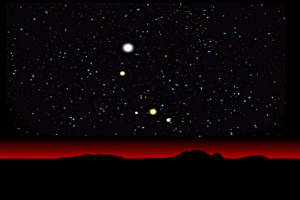The next big ticket alignment is on August 1st, when the Moon and the Sun occupy the same spot in the sky-the event we call a Total Solar Eclipse. As it happens, we won't be able to see this eclipse directly from the United States, as it will only be visible in Asia. However, NASA will be broadcasting live coverage of the eclipse from Northern China. We'll be showing NASA's broadcast in our planetarium at Chabot Space and Science Center, in case you'd care to come up and enjoy the spectacle. Don't let the fact that the live event goes on around 4:00 AM keep you away...it's worth getting up for!
A bit further out on the calendar is the September alignment of three planets: Venus, Mars, and Mercury. In the dusky twilight of mid-September evenings the three will be gathering. The closest grouping of the trio is on September 11th, when they will be within about three degrees of each other-close enough that you can just about cover all three with your thumb. Mercury and Mars won't be very bright in the twilight-but Venus, bright enough to spot easily, can help guide your eye to the other two. Using a pair of binoculars will help a lot-but make sure you don't point them that way until after the Sun sets....
In ancient times (and in some cases not so ancient times), different cultures around the world have viewed alignments like these in different ways. Eclipses-both solar and lunar-were regarded by many cultures as bad omens, or bad occurrences (such as the Sun being devoured by a celestial animal-dragon, dog or other-in the case of a solar eclipse).
Planetary alignments were also given special consideration, sometimes being regarded as auspicious (for good or bad-usually the latter). One major alignment of the five visible planets (February 26, 1953 BCE) was believed to have "mandated" the creation of the Hsia Dynasty in China-the first great Chinese Dynasty. (Then, four centuries later, Mars, Mercury, Jupiter and Saturn apparently conspired to bring down that same dynasty-at least, their alignment on December 20, 1576 BCE was interpreted as an indicator of the dynasty's corruption, and it was overthrown by a revolt of believers...).
However you regard the lining up of celestial bodies (astronomically, astrologically, or aesthetically), these alignments are pleasing to watch, and times to reflect upon the constant and cyclic movement among the heavens. Enjoy....
37.7631 -122.409
 Depiction of a major alignment of
Depiction of a major alignment of